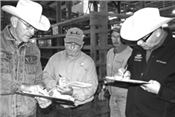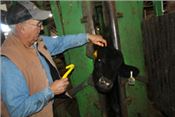Beef Farmers Learn From 50 Feedouts
JOPLIN, MO.
Missouri beef herd owners learn profits and risks of sending their calves to a feedlot. They’ve entered 50 Missouri Steer Feedouts run by University of Missouri Extension.
To cut risks in learning, they enter samples of five to 20 head, said Eldon Cole, MU Extension livestock specialist. The Missouri Steer Feedout for winter-spring born calves began Nov. 6 at the Joplin Regional Stockyards in Carthage. The program teaches cow-calf farmers to keep a sampling of their steer calves through harvest.
The steers go to Tri-County Steer Carcass Futurity in southwestern Iowa. Throughout the process, their weight gain, feedlot performance and herd health are noted. The feedlot manages them until they are harvested by Tyson Foods in Nebraska in the spring.
Cole, from Mount Vernon, has done this since 1981 with lots of help. Over the years, 365 owners have entered 7,557 steers in the Missouri Steer Feedout. Participants come from Arkansas, Kansas, Illinois, Oklahoma and Missouri.
Producers enter a minimum of five steers. Most herds consign 10-20 head to allow them to compare sires.
MU Extension livestock specialists, Southwest Missouri Cattlemen’s Association members, and employees of USDA and Missouri Department of Agriculture sorted, tagged, weighed, graded and priced 139 steers from 15 groups. They weighed an average of 639 pounds. An average set-in price of $151.73 will be used to calculate feedlot performance.
Farmers hear comments as a panel views the steers. The panel included Jodie Pitcock, USDA, St. Joseph; Dan Hill, Missouri Department of Agriculture, West Plains; Jackie Moore, Joplin Regional Stockyards; Matt Thompson, Crossroads Cattle Co., Columbia; Wes Spinks, order buyer, Jerico Springs; and Mark Harmon, Joplin Regional Stockyards. They discussed strengths and weaknesses of the steers, including frame, muscle score and body condition.
“The 15 lots of steers gave the audience a great chance to see the diversity of cattle in southwest Missouri,” says Cole. There were mostly Angus and Angus crosses. There were some Brahman crosses, straight Charolais and Red Angus. Body conditions ranged from 4 to 7. Calves were born late December to April.
Harmon gave tips on how to help the auctioneer get more bids on the cattle. Write down vaccination types and date and weaning dates on a recipe card to take to the auction barn, Harmon says. “Once you get information, put it to work,” Cole says.
Through the years, Missouri cattle producers learned “you can’t tell a steer’s post-weaning performance by its cover,” says Cole. “The only way you’ll learn your herd’s genetics for overall performance is to feed them at least two or three times.”
Cole says feedouts don’t guarantee more money. Since 1981, the average profit per head has been less than $50. The payoff comes when producers use results to adjust their genetics and management. Cole says most producers enter five to 15 head of cattle. This is a low-risk way to find strengths and weaknesses, he says. The program helps small herd owners gain data to improve their herd’s genetic reputation.
Cole urges participants to set reasonable goals and realize “there are lots of average cattle.” A goal is to have 70 to 80 percent of carcasses grade USDA choice or higher.
Steers are ranked on temperament when they are worked. Disposition matters. Graders also check for bad eyes, primarily pinkeye. Steers with eye problems generally weigh 34 pounds less at weaning and gain less in finishing.
Cole tells participants to track steer performance back to the sire and dam and use this data to market herd mates as feeders or breeding stock. He teaches producers about the feedlot and packer’s desired grid. Results should arrive in late May to early June.
Southwest Missouri Cattlemen’s Association President Russell Marion of Pierce City has enrolled in the program the last 16 years. His profit per head averaged $39.96, ranging from $328 to minus $185. He also weighs calves and operates the chute at the feedout weigh-in.
Cole urged Marion to enter calves several years ago. “I wanted to see what they would do in the feedlot,” he says. “This is another whole segment of our industry.”
Marion says he uses the feedout to learn about his own herd. He usually brings oddly colored calves that would not bring as much money at a livestock auction. For feeding, hair color does not matter. Judges put emphasis on carcass grades and yield. Marion has a 400-head operation and 200 acres of hay. He rents his row crop acres. ∆

Steers in the Missouri Steer Feedout go through an extensive grading by, from left,
MU Extension livestock specialist Eldon Cole; Dan Hill, Missouri
Department of Agriculture; and Jodie Pitcock, USDA. Looking on is
Gerald Eggerman, South Greenfield.
Photo by Linda Geist

Mount Vernon beef producer Steve Jones
removed old tags and tagged steers with a number to help feedlot operators track each
calf’s progress. He also brought two cattle of his own for the feedout.